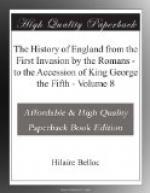Calling his men around him under the cover of the long broom on the moor, he prayed, sang a psalm, and declared that he had consulted the Almighty, and knew as assuredly as there was a God in heaven, that the enemies of Christ were delivered into their hands. Then dividing his small force of about four hundred men into several bodies, he showed at first a single troop of horse, whom the royalists prepared to receive with their cavalry; but after a short interval, appeared a second, then a third, then a fourth; and Montrose believing that Leslie’s entire army was advancing, ordered the infantry to take shelter among the brushwood and stunted trees on a neighbouring eminence. But before this movement could be executed, his horse were broken, and his whole force lay at the mercy of the enemy. The standard-bearer with several officers and most of the natives were slain; the mercenaries made a show of resistance, and obtained quarter; and Montrose, whose horse had been killed under him, accompanied by Kinnoul, wandered on foot, without a guide, up the valley of the Kyle, and over the mountains of Sutherland. Kinnoul, unable to bear the hunger and fatigue, was left and perished; Montrose, on the third day,[c] obtained refreshment at the hut of a shepherd; and, being afterwards discovered, claimed the protection of Macleod of Assynt, who had formerly served under him in the royal army. But the
[Sidenote a: A.D. 1650. April 25.] [Sidenote b: A.D. 1650. April 27.] [Sidenote c: A.D. 1650. April 30.]
fidelity of the laird was not proof against temptation; he sold[a] the king’s lieutenant for four hundred bolls of meal; and Argyle and his associates, almost frantic with joy, passed an act to regulate the ignominious treatment to which their captive should be subjected, the form of the judgment to be pronounced, and the manner of his subsequent execution. When Montrose reached[b] the capital, he found the magistrates in their robes waiting to receive him. First the royal officers, twenty-three in number, were ranged in two files, and ordered to walk forward manacled and bareheaded; next came the hangman with his bonnet on his head, dressed in the livery of his office, and mounted on his horse that drew a vehicle of new form devised for the occasion; and then on this vehicle was seen Montrose himself, seated on a lofty form, and pinioned, and uncovered. The procession paraded slowly through the city from the Watergate to the common jail, whilst the streets resounded with shouts of triumph, and with every expression of hatred which religious or political fanaticism could inspire.[1]
From his enemies Montrose could expect no mercy; but his death was hastened, that the king might not have time to intercede in his favour. The following day, a Sunday, was indeed given to prayer; but on the next the work of vengeance was resumed, and the captive was summoned[c] before the parliament. His features, pale and haggard, showed the fatigue and privations which he had endured; but his dress was




